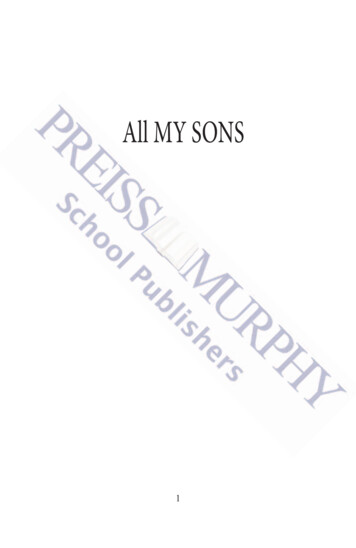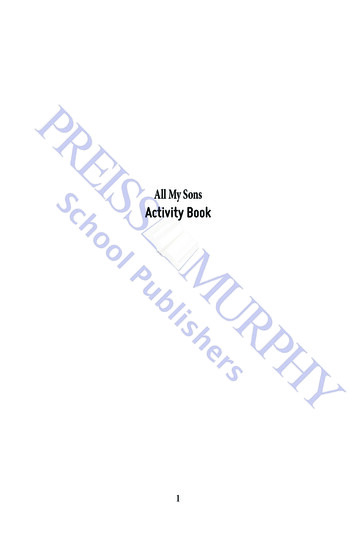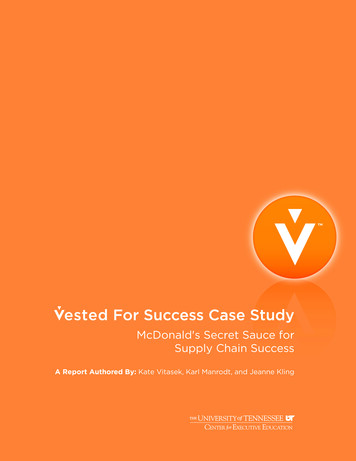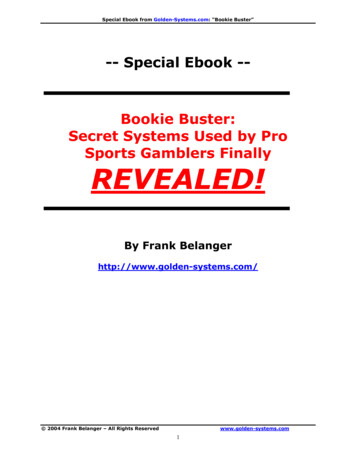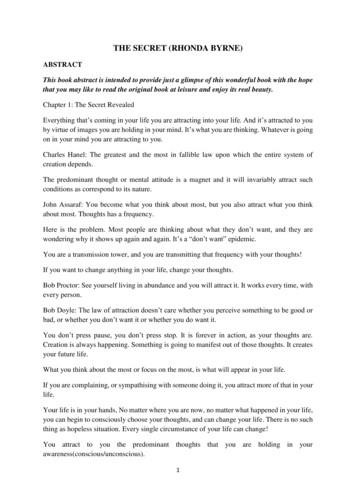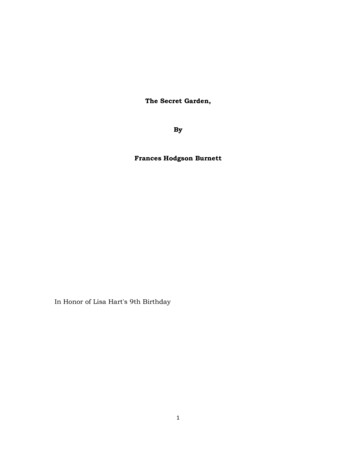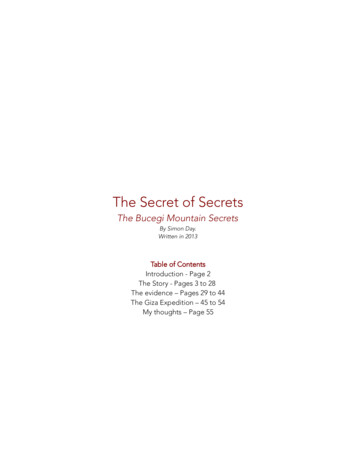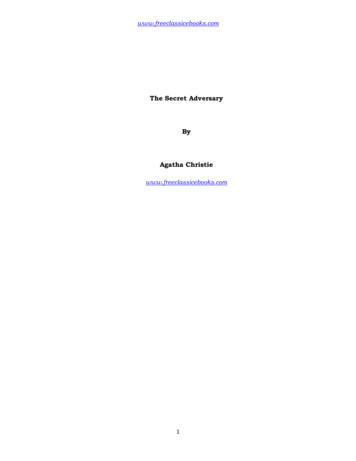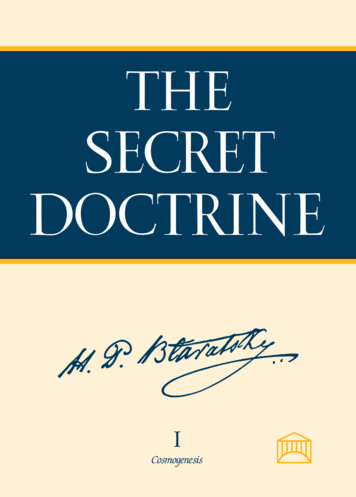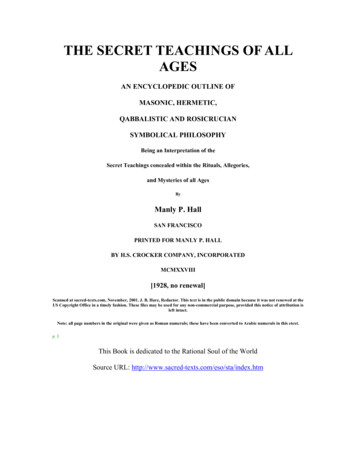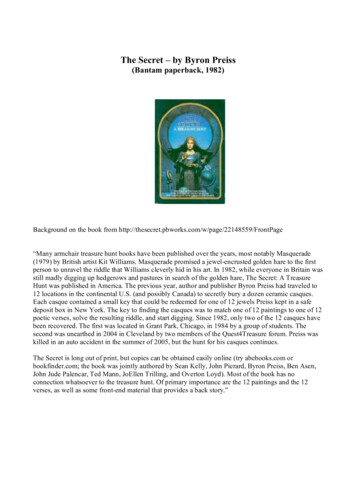
Transcription
The Secret – by Byron Preiss(Bantam paperback, 1982)Background on the book from Page“Many armchair treasure hunt books have been published over the years, most notably Masquerade(1979) by British artist Kit Williams. Masquerade promised a jewel encrusted golden hare to the firstperson to unravel the riddle that Williams cleverly hid in his art. In 1982, while everyone in Britain wasstill madly digging up hedgerows and pastures in search of the golden hare, The Secret: A TreasureHunt was published in America. The previous year, author and publisher Byron Preiss had traveled to12 locations in the continental U.S. (and possibly Canada) to secretly bury a dozen ceramic casques.Each casque contained a small key that could be redeemed for one of 12 jewels Preiss kept in a safedeposit box in New York. The key to finding the casques was to match one of 12 paintings to one of 12poetic verses, solve the resulting riddle, and start digging. Since 1982, only two of the 12 casques havebeen recovered. The first was located in Grant Park, Chicago, in 1984 by a group of students. Thesecond was unearthed in 2004 in Cleveland by two members of the Quest4Treasure forum. Preiss waskilled in an auto accident in the summer of 2005, but the hunt for his casques continues.The Secret is long out of print, but copies can be obtained easily online (try abebooks.com orbookfinder.com; the book was jointly authored by Sean Kelly, John Pierard, Byron Preiss, Ben Asen,John Jude Palencar, Ted Mann, JoEllen Trilling, and Overton Loyd). Most of the book has noconnection whatsoever to the treasure hunt. Of primary importance are the 12 paintings and the 12verses, as well as some front end material that provides a back story.”
Twelve boxes (or “casques” as they were called) were buried, but only two have been found. The firstone was discovered by a group of students in 1984, in Grant Park in Chicago. This is how it worked.Where M and B are set in stoneAnd to Congress, R is knownL sits and leftBeyond his shoulderIs the Fair Folks'Treasure holderThe end of ten by thirteenIs your clueFence and fixtureCentral tooFor finding jewel casqueSeek the soundsOf rumbleBrush and musicHush.
The verse describes various landmarks in the area of Grant Park.Where M and B are set in stone1 The names of Mozart and Beethoven appear on the front of Symphony Hall.And to Congress, R is known2 Roosevelt University on Congress ParkwayL sits and left3 Statue of LincolnBeyond his shoulder4 Shows the position of the casque“The end of ten by thirteen” referred to two lines of trees. “Fence and fixture” referred to this fencepostand wall fixture. The casque was apparently found between them. (That tree wasn’t there at the time.)
Several landmarks around Grant Park appeared disguised within the image, including the statue “Spiritof the Great Lakes” “The Bowman” and the fencepost
This is the picture and verse which are thought to relate to New Orleans:
At stone wall's doorThe air smells sweetNot far awayHigh posts are threeEducation and JusticeFor all to seeSounds from the skyNear ace is highRunning north, but first acrossIn jewel's directionIs an objectOf Twain's attentionGiant poleGiant stepTo the placeThe casque is kept.Some of these puzzles seem to be based around a particular location, while others involve a trail arounda city from one point to another. I think this one involves a simple trail starting at Jackson Square andending at Louis Armstrong Park.At stone wall's doorThe air smells sweetThis could be a reference to “Stonewall Jackson” and Jackson Square, near the Café du Monde. Thesigns at the entrance to Jackson have a flowers and crown motif which resembles the clockface Not far awayHigh posts are threeEducation and JusticeFor all to see
Perhaps this refers to the spires of St Louis Cathedral, with the adjoining Presbytere (once acourthouse) and Cabildo (once the Supreme Court), both now museums.Running north, but first acrossIn jewel's directionIs an objectOf Twain's attentionFrom here, St Peter St runs northwest past Preservation Hall, which is suggested in the image. (Thedoorway is opposite the sign.)The “object of Twain’s attention” is St Peter’s (in Rome) which Twain wrote about in “The InnocentsAbroad”.
Giant poleGiant stepTo the placeThe casque is kept.Continuing up St Peter’s you reach Congo Square and the “Mardi Gras” arch at the entrance to LouisArmstrong Park.
The mask (a Mardi Gras mask?) resembles the park’s statue of Louis Armstrong: and the arch appears disguised in Armstrong’s mouth There are also other arch representations
Each image is associated with a country (France in this case) and a month, with its birthstone and birthflower. For this image, the 12 on the clock gives us December, with the Turquoise and Narcissus.There’s a verse in the introduction to the book which lists the countries and their associated gems:Turquoise the Fays of France keep: stoneRare as a blue midsummer dayHere we see the turquoise under the arch, and “Pres”, French for “near”, at one end of the arch.It’s thought that the boy on the clockface represents the child climbing the McDonough statue inLafayette Square:
This has led some people to think that the casque is in Lafayette Square. However, I think this isactually an obscure hint for one of the McDonough schools, McDonough 18, aka the Rabassa / DePouilly House in Louis Armstrong Park.This could explain the boy’s arc The clock has three numbers on it; 19 and 29 along the top, and 90 at the bottom. 29 and 90 give thelatitude and longitude of New Orleans. 1929 might be a reference to the date of the park’s MunicipalAuditorium. It’s also been pointed out that McDonough #19 is the Armstrong school.The “Giant Step” could be an allusion to Armstrong’s “Small step / giant leap”, explaining the moonand stars in the image. (This could also be a reference to Moon Landrieu, the mayor who initiated theLouis Armstrong Park project.) The “Giant pole” might be the large N or S on the sign.I was wondering if it might be buried here, beside the arch “Not far away high posts are three” ?
This is what was buried, up to 3ft deep in a plastic container.Although there’s no prize anymore, anyone finding one of these would have the box as a souvenir, andthey’d be regarded as a hero by the people at the “Quest4Treasure” website ; )Only one has been recovered intact, the Cleveland one having been reduced to fragments.If anyone ever finds it please let us know!Ben GloverB J Glover@yahoo.co.ukDiscussion forum at:www.quest4treasure.co.uk
Here’s an article about the first casque that was found, though its explanation of the clues isn’taccurate.Here’s an article about the Grant Park discovery, though it’s not entirely accurate
The Secret is long out of print, but copies can be obtained easily online (try abebooks.com or bookfinder.com; the book was jointly authored by Sean Kelly, John Pierard, Byron Preiss, Ben Asen, John Jude Palencar, Ted Mann, JoEllen Trilling, and Overton Loyd). Most of the book has no
